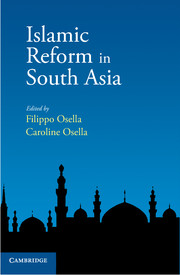Book contents
- Frontmatter
- Contents
- List of Contributors
- Introduction
- Part I Reformist Journeys
- Part II Debating Reform
- 5 The Enemy Within: Madrasa and Muslim Identity in North India
- 6 Islamism and Social Reform in Kerala, South India
- 7 Piety as Politics Amongst Muslim Women in Contemporary Sri Lanka
- 8 The Changing Perspectives of Three Muslim Men on the Question of Saint Worship over a 10-Year Period in Gujarat, Western India
- 9 Women, Politics and Islamism in Northern Pakistan
- 10 Violence, Reconstruction and Islamic Reform: Stories from the Muslim ‘Ghetto’
- Part III Everyday Politics of Reform
- Part IV Reform, State and Market
- Index
5 - The Enemy Within: Madrasa and Muslim Identity in North India
from Part II - Debating Reform
Published online by Cambridge University Press: 05 January 2014
- Frontmatter
- Contents
- List of Contributors
- Introduction
- Part I Reformist Journeys
- Part II Debating Reform
- 5 The Enemy Within: Madrasa and Muslim Identity in North India
- 6 Islamism and Social Reform in Kerala, South India
- 7 Piety as Politics Amongst Muslim Women in Contemporary Sri Lanka
- 8 The Changing Perspectives of Three Muslim Men on the Question of Saint Worship over a 10-Year Period in Gujarat, Western India
- 9 Women, Politics and Islamism in Northern Pakistan
- 10 Violence, Reconstruction and Islamic Reform: Stories from the Muslim ‘Ghetto’
- Part III Everyday Politics of Reform
- Part IV Reform, State and Market
- Index
Summary
It is true that the BJP and other Hindu organizations hate Muslims. But at least they hate us openly and do not hide their intentions. But the real enemy lives amongst us; they claim to be Muslims and yet are leading the Muslims astray. They are the greatest enemy of Islam.
(A student at Madras a Ashrafia, Mubarakpur)Introduction
Long before 9/11, madrasas were made infamous in India by Hindu Right wing parties. The Bhartiya Janata Party (BJP), the Vishwa Hindu Parishad (VHP) and their ideological fountainhead, the Rashtriya Swayamsevak Sangh (RSS), all blamed the madrasas for teaching hatred towards the majority (Hindu) community and engaging in what they claimed were anti-national activities. In 1995, the VHP declared that it would not tolerate the nefarious designs of madrasas as they were teaching ‘anti-Hindu’ ideas to their students. The Hindu Right termed the madrasas ‘dens of terror’ training jihadis to massacre Hindus and turn India into an Islamic nation. During the BJP led government, a ministerial committee report of 2001 stated that madrasas were engaged in systematic indoctrination of Muslims in fundamentalist ideology, which was detrimental to communal harmony (Sikand 2005: 271). The Report suggested that ‘modern education’ be imparted in madrasas in an effort to bring them into the ‘national mainstream’. Certainly, while in power the BJP could persuade only a handful of madrasas to introduce modern subjects, for which grants were made available by the state.
- Type
- Chapter
- Information
- Islamic Reform in South Asia , pp. 117 - 138Publisher: Cambridge University PressPrint publication year: 2013

